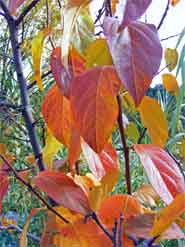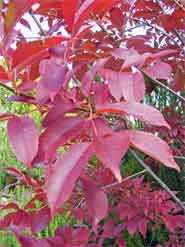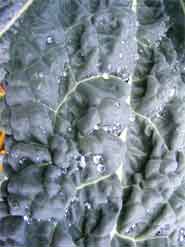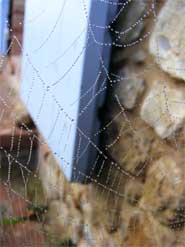CdP
10 November 2009



The setting point of jam at sea level is 105 degrees. Jelly, some people say, sets at 104 degrees. We, however, are almost 500m up. So our setting point should, I reckon, be somewhere between 102 and 103 degrees. This is a temperature which, alas, my jam almost never gets to. It hovers tantalisingly around 99 and sometimes edges up to 101. With the dramatic exception of some crabapple jelly I made the other day which shot terrifyingly straight up to 108. The medlar jelly I made this morning bubbled furiously but, despite the fact I cranked the gas up as high as it would possibly go, it only hit 100 degrees for the briefest of instants. Logic tells me that this may have something to do with quantities of sugar, but I always put something between 25 and 30 percent sugar to fruit… in a rather unscientific manner, I have to admit because I usually forget to weigh the fruit before I stick it in the pot therefore have to guess the amount of sugar. So the sugar proportions are more or less the same all the time. So what’s the difference? Can the pectin content decide how hot it goes?
I’ve just discovered that medlars have very little pectin whereas crabapples have lots. Yesterday, on a trip to a garden I’m working on near Spello, I filled a huge bag full of quinces. They’re boiling on the stove right now. Once again, the medlars I did yesterday are more syrup than jelly. The little bit of crabapple I made looks like it’s going to be a solid lump. Let’s see what the quinces do. (A PS: the answer is, they took forever. In fact, I have come to the decision that reaching the right jelling temperature depends entirely on the fruit/sugar ratio. I boiled and boiled and boiled my high-pectin quinces, entirely baffled by the way that the temperature remained unchanged, however high I cranked up the heat, and the contents of my saucepan remained resolutely runny. Then, at a certain point – a point, in fact, when I was giving up and had turned the heat down – the temperature shot up of its own accord. Clearly, sufficient liquid had boiled off to bring the ratio to where it should be. How infuriating that I can't decide for myself.)
In fact, what the quinces were doing as I wrote was sticking to the bottom of the infuriating saucepan I bought specially for jam-making which seems to make everything burn unless I stand over it, stirring constantly. I’ve decanted the lot into the jelly bag now, and I’m just hoping that the strings it’s hanging from are strong enough to bear the weight of so much fruit.
The other thing that’s going on as I write is that the robin, who suddenly reappeared yesterday after its summer hols, is throwing itself at the windows, desperate for someone to go out to play. L said that yesterday, while I was away working, it did the same thing, and only stopped when L went out to run around the house which is his preferred form of exercise at the moment. The robin bobbed and darted about, not quite under his feet but as close as he could reasonably get without fear of being trampled. Oh no, how disappointing! I’ve just done some research and it’s not for love of us that he’s battering the panes: it’s because he can see a reflection of himself in the glass and wants to drive off a possible rival. Silly animal! I guess he’ll settle down eventually and realise his mistake. At least I hope so, because it’s most off-putting sitting here trying to work and listening to him scrabbling about out there. On the other hand, it’s very nice having him sitting on the outside table or in the big olive tree singing to me. And I do love his company when I’m working in the garden.
Though working in the garden is, for some reason, something I never seem to get around to these days. I must get my act together. After a brief spurt when I built a new bed behind the artichoke bank – more artichokes, Rosa chinensis mutabilis, Lavandula dentata plus what I hope will become a thick hedge of Feijoa sellowiana (if it survives the cold) along the slope that leads to the top orchard layer – I kind of got lazy. Now what I need is a few days among my vegetables. The runner and french beans, which did nothing at all over the hot summer, had a magnificent last spurt and provided great handfuls of beans for several weeks. They now need to be grubbed out. And the last of the tomatoes have been transformed into great piles of green tomato chutney. Those plants need to go too. The fennel is still going strong, and the black turnips are looking healthy, despite being in that back bed near the compost bins which gets so very little sun at this time of year.
All the brassicas that I stuck, far too close to each other, in one bed over the summer, now need to be thinned out and transplanted in the tomato bed, and I have to start thinking about onions and garlic.
On the way home from Spello the other day, I took a detour to Cannara, which is famous for its onions. It’s not quite like tropea onions, which are long and deep purply red and a separate variety. They grow onions of all types in Cannara, though there’s a particular bronze-coloured one with reddish flesh which is particularly associated with the town. Whether or not it’s a proper variety or whether it’s just that the soil there does exceptionally fine things to onions, I’ve tried to work out with no success. Anyway, it was a dark and very wet night and all the roads around seemed to be closed off for road works and all that happened was that I got hopelessly lost, and decided that I’d just go to our local consorzio agricolo here for my onion sets. Trying to get the Cannara ones seemed far too troublesome. A touch pathetic, I know, but they’ll do.
In fact, the only outside task I’ve managed to complete with any degree of success over the past few days is sieving my wonderful compost. I am so proud of this summer’s crop. The compost in the bins is all right, but the stuff in the makeshift pile – a couple of up-ended palettes behind the chicken house where I chuck any old weedy bits and pieces that I can’t be bothered to heave across to the proper bins – is a triumph. Planting grass seed around there in a futile attempt to make a semi-decent lawn in the middle of a long dry summer was looking like a complete waste of time and effort until I realised that all the water I had sprinkled in my desperate bid to keep the so-called lawn alive had turned that unplanned pile into beautiful crumbly rich compost of the highest quality. Which just goes to show that careful weighing up of the various compost components, and painstaking turning and wetting down in specially-made bins is all very well, but haphazard abandonment and total neglect can be just as good. That gave me a lot of satisfaction.



